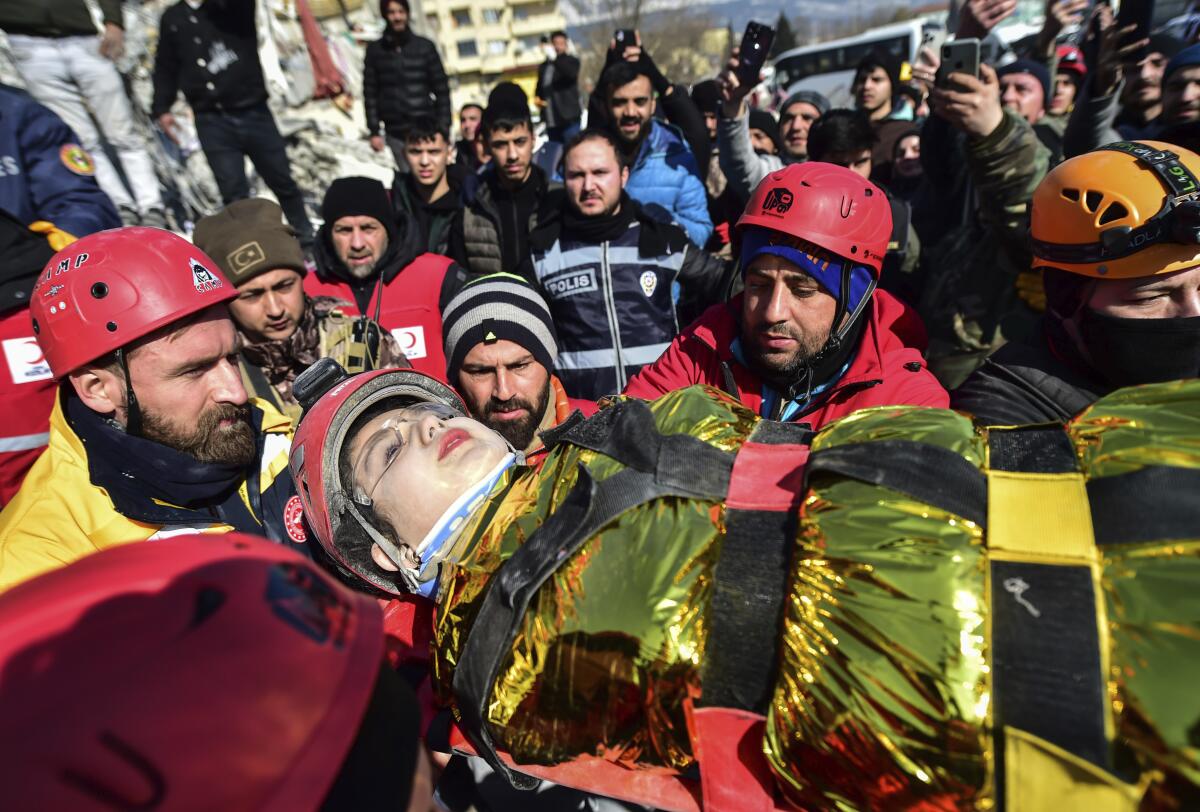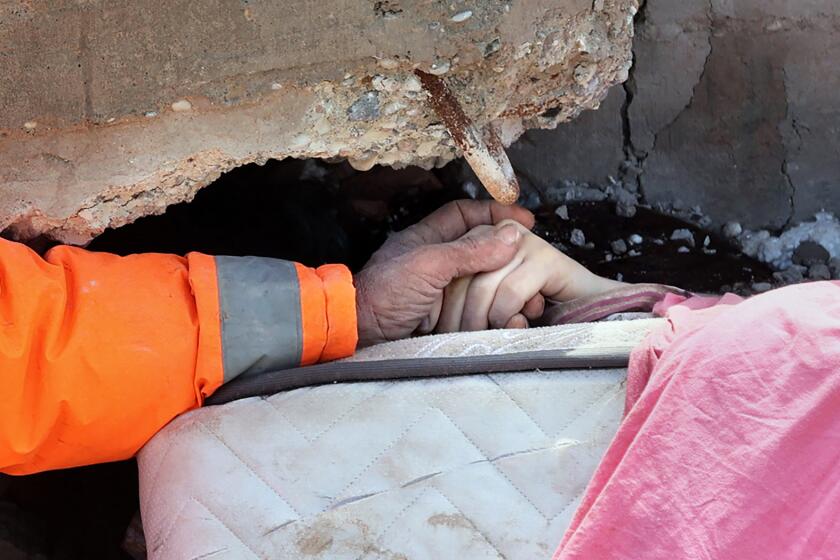Earthquake death toll eclipses 20,000 in Turkey and Syria

- Share via
KAHRAMANMARAS, Turkey — Rescue workers made a final push Thursday to find survivors of the earthquake in Turkey and Syria that rendered many communities unrecognizable to their inhabitants and led the Turkish president to declare it “the disaster of the century.” The death toll topped 20,000.
The earthquake affected an area that is home to 13.5 million people in Turkey and an unknown number in Syria and stretches farther than the distance from London to Paris or Boston to Philadelphia. Even with an army of people taking part in the rescue effort, crews had to pick and choose where to help.
The scene from the air showed the scope of devastation, with entire neighborhoods of high-rises reduced to twisted metal, pulverized concrete and exposed wires.
In Adiyaman, Associated Press journalists saw someone plead with rescuers to look through the rubble of a building where relatives were trapped. They refused, saying that no one was alive there and that they had to prioritize areas with possible survivors.
A man who gave his name only as Ahmet out of fear of government retribution later asked the AP: “How can I go home and sleep? My brother is there. He may still be alive.”
For the record:
9:30 p.m. Feb. 9, 2023An earlier version of this story incorrectly said that Istanbul is Turkey’s capital.
The death toll from Monday’s magnitude 7.8 catastrophe rose to nearly 21,000, eclipsing the more than 18,400 who died in the 2011 earthquake off Fukushima, Japan, that triggered a tsunami and the estimated 18,000 people in Turkey who died in a temblor near Istanbul in 1999.
The new figure, which is certain to rise, included over 17,600 people in Turkey and more than 3,300 in war-torn Syria. Tens of thousands were also injured.
Even though experts say people could survive for a week or more, the chances of finding survivors in the freezing temperatures were dimming. As emergency crews and relatives dug through the rubble — and occasionally found people alive — the focus began to shift to demolishing dangerously unstable structures.
The DHA news agency broadcast the rescue of a 10-year-old in Antakya. The agency said that medics had to amputate an arm to free her and that her parents and three siblings had died. A 17-year-old girl emerged alive in Adiyaman, and a 20-year-old was found in Kahramanmaras by rescuers who shouted, “God is great.”
In Nurdagi, a city of around 40,000 set between snowy mountains some 35 miles from the epicenter, vast swaths were leveled, with scarcely a building unaffected. Even those that did not collapse were heavily damaged, making them unsafe.
Throngs of onlookers, mostly relatives of people trapped inside, watched as heavy machines ripped at one building that had collapsed, its floors pancaked together with a few inches in between.
Mehmet Yilmaz, 67, watched from a distance as bulldozers and other demolition equipment began to bring down what remained of the building where six of his family members had been trapped, including four children.
He estimated that about 80 people were still beneath the rubble and doubted that anyone would be found alive.
“There’s no hope. We can’t give up our hope in God, but they entered the building with listening devices and dogs, and there was nothing,” Yilmaz said.
Mehmet Nasir Dusan, 67, sat watching as the remnants of the nine-story building were brought down in billowing clouds of dust. He said he held no hope of reuniting with his five family members trapped under the debris.
Still, he said, recovering their bodies would bring some small comfort.
“We’re not leaving this site until we can recover their bodies, even if it takes 10 days,” Dusan said. “My family is destroyed now.”
In Kahramanmaras, a sports hall the size of a basketball court served as a makeshift morgue to accommodate and identify bodies.
On the floor lay dozens of bodies wrapped in blankets or black shrouds. At least one appeared to be that of a 5- or 6-year-old.
At the entrance, a man wept over a black body bag that lay next to another in the bed of a small truck. “I’m 70 years old. God should have taken me, not my son,” he cried.
Workers continued to conduct rescue operations in Kahramanmaras, but it was clear that many who were trapped in collapsed buildings had already died. One rescue worker was heard saying that his psychological state was declining and that the smell of death was becoming too much to bear.
In northwestern Syria, the first United Nations aid trucks since the quake to enter the rebel-controlled area from Turkey arrived, underscoring the difficulty of getting help to people there.
One survivor, Ahmet Tokgoz, called for the government to evacuate people from the region. Many of those who have lost their homes found shelter in tents, stadiums and other temporary accommodation, but others have slept outdoors.
“Especially in this cold, it is not possible to live here,” he said. “If people haven’t died from being stuck under the rubble, they’ll die from the cold.”
The winter weather and damage to roads and airports have hampered the response. Some in Turkey have complained that the government was slow to respond — a perception that could hurt Turkish President Recep Tayyip Erdogan at a time when he faces a tough battle for reelection in May.
“As you know, the earthquake hit an area of 500-kilometer diameter” — more than 300 miles —”where 13.5 million of our people live, and that made our job difficult,” Erdogan said Thursday.
In the Turkish town of Elbistan, rescuers stood atop the rubble from a collapsed home and pulled out an elderly woman.
Rescue teams urged quiet in the hopes of hearing stifled pleas for help, and the Syrian paramedic group known as the White Helmets noted that “every second could mean saving a life.”
But more and more often, the teams pulled out dead bodies. In Antakya, more than 100 bodies were awaiting identification in a makeshift morgue outside a hospital.
With the chances of finding people alive dwindling, crews in some places began demolishing buildings. Authorities called off search-and-rescue operations in the cities of Kilis and Sanliurfa, where destruction was not as severe as in other areas. Vice President Fuat Oktay said rescue work was mostly complete in Diyarbakir, Adana and Osmaniye.
Across the border in Syria, assistance trickled in. The U.N. is authorized to deliver aid through only one border crossing, and road damage has prevented that thus far. U.N. officials pleaded for humanitarian concerns to take precedence over wartime politics.
The death toll is in the thousands after a magnitude 7.8 earthquake, followed by a magnitude 7.5 quake, struck southern Turkey.
It was not clear how many people were still unaccounted for in both countries.
Among the missing were members of a high school volleyball team from northern Cyprus, as well as teachers and parents who had been staying in a hotel that collapsed, said Nazim Cavusoglu, the education minister in the breakaway Turkish Cypriot north, on Turkey’s NTV television.
Turkey’s disaster-management agency said more than 110,000 rescue personnel were now taking part in the effort, and more than 5,500 vehicles, including tractors, cranes, bulldozers and excavators, had been shipped. The Foreign Ministry said 95 countries have offered help. More than half that number have sent a total of nearly 6,500 rescuers. An additional 2,400 are still expected to arrive.
Alsayed reported from Bab al-Hawa, Syria, and Bilginsoy from Istanbul. Associated Press journalists Suzan Fraser in Ankara, Turkey; Emrah Gurel and Yakup Paksoy in Adiyaman, Turkey; Robert Badendieck in Istanbul; Bassem Mroue and Abby Sewell in Beirut; and David Rising in Bangkok contributed to this report.
More to Read
Sign up for Essential California
The most important California stories and recommendations in your inbox every morning.
You may occasionally receive promotional content from the Los Angeles Times.











